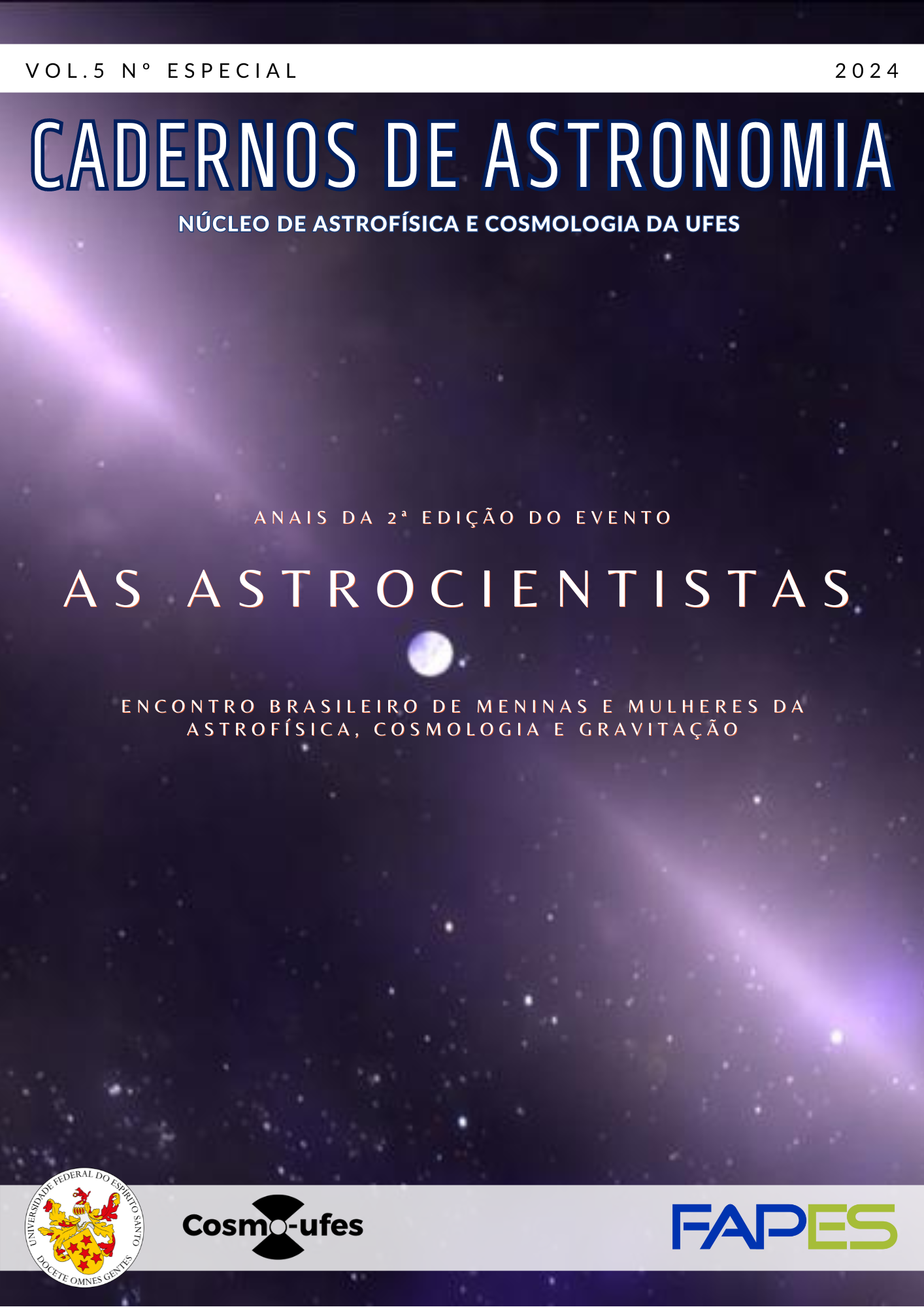Propriedades estelares de galáxias compactas massivas no Universo Local
DOI:
https://doi.org/10.47456/Cad.Astro.v5nEspecial.44989Palavras-chave:
Astrofísica, galáxia, matéria escuraResumo
As galáxias compactas massivas (MCGs) são galáxias quiescentes caracterizadas, neste trabalho, com altos valores de dispersão de velocidades efetiva, massa estelar e pequenos valores de raio efetivo. Com o objetivo de investigar a formação e evolução das MCGs, nós determinamos as propriedades das populações estelares de 1858 MCGs derivadas do levantamento Sloan Digital Sky Survey. Comparamos os resultados com uma amostra de galáxias controle (CSGs) (galáxias quiescentes com tamanhos médios) pareada em redshift com as MCGs. Comparamos os resultados à dispersão de velocidades fixa e encontramos diferenças entre as propriedades das populações estelares, especialmente para a metalicidade estelar: MCGs apresentam menor metalicidade que CSGs à dispersão de velocidades fixa. Os resultados apresentados ainda não são suficientes para determinar o caminho evolutivo das MCGs, mas podem indicar diferenças associadas à função de massa inicial ou da fração de matéria escura dentro de 1 raio efetivo nas MCGs.
Referências
D. Thomas et al., The Epochs of Early-Type Galaxy Formation as a Function of Environment, Astrophysical Journal 621(2), 673 (2005). ArXiv:astro-ph/0410209.
A. van der Wel et al., 3D-HST+CANDELS: The Evolution of the Galaxy Size-Mass Distribution since z = 3, Astrophysical Journal 788(1), 28 (2014). ArXiv:1404.2844.
T. Naab, P. H. Johansson e J. P. Ostriker, Minor Mergers and the Size Evolution of Elliptical Galaxies, Astrophysical Journal Letters 699(2), L178 (2009). ArXiv:0903.1636.
P. G. van Dokkum, K. E. Whitaker e et al., The Growth of Massive Galaxies Since z = 2, Astrophysical Journal 709(2), 1018 (2010). ArXiv:0912.0514.
B. Abolfathi et al., The Fourteenth Data Release of the Sloan Digital Sky Survey: First Spectroscopic Data from the Extended Baryon Oscillation Spectroscopic Survey and from the Second Phase of the Apache Point Observatory Galactic Evolution Experiment, Astrophysical Journal Supplement 235(2), 42 (2018). ArXiv: 1707.09322.
M. Cappellari, Structure and kinematics of early-type galaxies from integral field spectroscopy, Annual Review of Astronomy and Astrophysics 54, 597 (2016). ArXiv:1602. 04267.
A. Vazdekis et al., Evolutionary stellar population synthesis with MILES - II. Scaled-solar and α-enhanced models, Monthly Notices of the RAS 449(2), 1177 (2015). ArXiv:1504. 08032.
A. Schnorr-Müller et al., The puzzling origin of massive compact galaxies in MaNGA, Monthly Notices of the RAS 507(1), 300 (2021). ArXiv: 2104.12737.
M. Trevisan, G. A. Mamon e H. G. Khosroshahi, Do the stellar populations of the brigh-test two group galaxies depend on the magnitude gap?, Monthly Notices of the RAS 464(4),4593 (2017). ArXiv:1604.07726.
G. J. Graves e S. M. Faber, Dissecting the red sequence. III. Mass-to-light variations in three-dimensional fundamental plane space, Astrophysical Journal 717(2), 803 (2010). ArXiv:1005.0014.
Downloads
Publicado
Edição
Seção
Licença
Copyright (c) 2024 K. Slodkowski Clerici, A. Schnorr-Müller, M. Trevisan, T. V. Ricci

Este trabalho está licenciado sob uma licença Creative Commons Attribution 4.0 International License.






